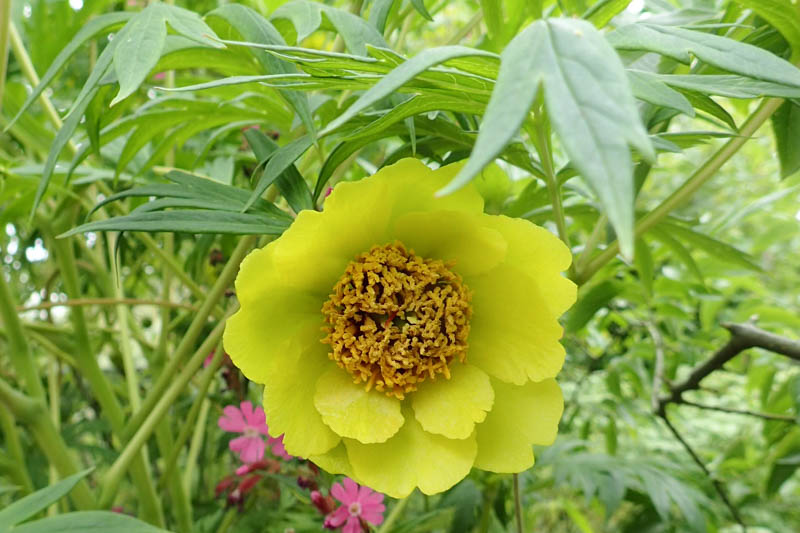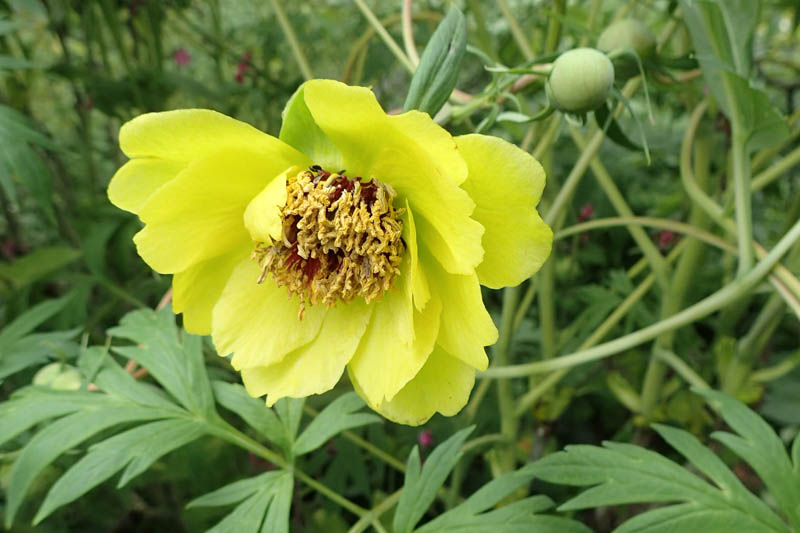Yellow Tree Peony, Paeonia lutea, Paeonia delavayi f. superba
Paeonia delavayi var. lutea, commonly known as the yellow tree peony, is a striking ornamental plant celebrated for its vibrant blooms and elegant stature.
Paeonia delavayi lutea is a deciduous shrub that is part of the tree peony group. It is noted for its large, cup-shaped, vibrant yellow flowers which are a highlight in any garden setting. The plant has a woody base and produces lush green foliage that adds to its ornamental appeal.
Native: This peony species is native to southwestern China, particularly found in regions like Yunnan. It grows naturally on mountain slopes and in woodland areas, often at high altitudes.
Plant Type and Habit: The Yellow Tree Peony is a woody perennial shrub that forms a substantial and bushy presence in the landscape. Unlike herbaceous peonies that die back to the ground each winter, tree peonies retain their woody structure year-round.
Size: The plant typically reaches about 3 to 5 feet in height (90-150 cm) and spreads 3-4 feet wide (90-120 cm). Its size makes it suitable as a focal point in garden designs.
Flowers: The plant produces large, bowl-shaped flowers, each up to 6 inches across (15 cm), in a striking shade of yellow. The blooms are sometimes accented with a red center, adding to their dramatic effect.
Blooming Season: Flowering occurs in late spring to early summer, providing a vibrant display when many other spring blooms are fading. After blooming, it produces seed pods that are also visually interesting. The pods open in late summer or early fall to reveal seeds with a shiny, blue-black coat encased in a fleshy, pink outer covering.
Foliage: The leaves are deeply divided, green, and have a leathery texture, providing a lush backdrop to the bright flowers and adding texture to the garden throughout the growing season.
Uses: This tree peony is primarily used as an ornamental shrub in landscapes. It is ideal for borders, foundation plantings, or as a specimen plant in a prominent location due to its striking flowers and foliage.
Hardiness: This tree peony is hardy in USDA zones 4 through 8. It requires some protection from harsh winter winds and extreme cold in the northern edges of its range.
Toxicity: Like other peonies, this peony is toxic to cats, dogs, and horses if ingested.
Wildlife: The vibrant flowers attract pollinators such as bees and butterflies, contributing to local biodiversity.
Deer and Rabbit: It’s relatively resistant to deer and rabbits.
Invasiveness: This plant is not considered invasive. It grows slowly and tends to stay confined to the area where it is planted without spreading aggressively.
Benefits: In addition to its aesthetic appeal, Paeonia delavayi lutea helps support local biodiversity by attracting pollinators. Its structure also provides shelter for small wildlife.

Planting: The best time to plant Paeonia delavayi lutea is in the fall, allowing the roots to establish before the onset of winter. Dig a hole about twice as wide and just as deep as the root ball. Mix in compost with the native soil to enrich it, place the plant in the hole so that the roots are spread out and the base of the stem is level with the soil surface, then fill in with the soil mixture and firm it down.
Light: This tree peony thrives in full sun to partial shade. In hotter climates, some afternoon shade is beneficial to protect the blooms from intense sun.
Wind Protection: Choose a location sheltered from strong winds, as the large flowers and branches can be damaged by harsh gusts.
Soil: Paeonia delavayi lutea prefers well-drained, fertile soil. It does well in slightly acidic to neutral soil. Good drainage is crucial to prevent root rot. If you have heavy or clay soil, amend it with compost and perlite or coarse sand to improve drainage.
Water: Water regularly to keep the soil moist but not soggy, especially during dry spells. Once established, Paeonia delavayi lutea is moderately drought-tolerant but benefits from consistent moisture. Use drip irrigation or water at the base to avoid wetting the foliage, which can lead to fungal diseases.
Fertilizer: Use a balanced, slow-release fertilizer designed for flowering shrubs or a specialty peony fertilizer. Fertilize in early spring as new growth appears and again after flowering if the growth seems sluggish.
Mulching: Mulch helps retain soil moisture, keeps roots cool, and suppresses weeds. Use organic mulch such as shredded bark or well-rotted compost. Apply a 2-3 inch layer around the base of the plant, keeping it away from the direct stem.
Pruning: Prune in late winter or early spring before new growth starts. Remove any dead or damaged wood and shape the plant if necessary. Tree peonies generally require minimal pruning compared to herbaceous peonies.
Winter Care: In zones close to its cold hardiness limit (USDA zone 5), protect the base of the plant with an extra layer of mulch to insulate the roots.
Propagation: Propagate by semi-hardwood cuttings.

The Yellow Tree Peony is considered to be relatively pest-free.
Botrytis Blight: This fungal disease is prevalent in wet, cool spring weather and can cause wilting and rotting of stems and buds. Ensure good air circulation around your plants and avoid overhead watering. Infected plant parts should be removed and destroyed, and fungicide applications might be necessary in severe cases.
Peony Leaf Blotch: This fungal disease, caused by Cladosporium paeoniae, manifests as red or purple blotches on peony leaves, eventually causing them to blight and fall off. Effective control includes good sanitation, adequate air circulation, and fungicidal treatments if necessary.
Verticillium Wilt: A soil-borne fungal disease that leads to the yellowing and wilting of leaves, often resulting in the death of the plant. Management involves removing affected plants, improving soil health, and selecting resistant varieties.
Root rot: Overwatering can lead to root rot, particularly in poorly draining soils. Ensure the planting site has excellent drainage and water only when the top inch of soil is dry.
Sun Scorch: While the plant can handle full sun, in hotter climates or during particularly intense heatwaves, the leaves might scorch. Providing afternoon shade can help mitigate this issue.
Improper Pruning: Tree peonies require minimal pruning. Over-pruning or pruning at the wrong time (such as late spring or summer) can stress the plant and reduce flowering. Prune only to remove dead or diseased wood, and shape the plant if necessary during late winter.
Fertilizer Burn: Over-fertilization can harm the plant, causing leaf burn and other growth issues. Use a balanced fertilizer sparingly in early spring and possibly after flowering if the plant seems to need a boost.
| Hardiness |
4 - 8 |
|---|---|
| Plant Type | Shrubs |
| Plant Family | Paeoniaceae |
| Genus | Paeonia |
| Common names | Peony |
| Exposure | Full Sun, Partial Sun |
| Season of Interest |
Spring (Late) Summer (Early) |
| Height |
3' - 5' (90cm - 150cm) |
| Spread |
3' - 4' (90cm - 120cm) |
| Spacing |
36" - 48" (90cm - 120cm) |
| Maintenance | Low |
| Water Needs | Average |
| Soil Type | Chalk, Clay, Loam, Sand |
| Soil pH | Acid, Alkaline, Neutral |
| Soil Drainage | Moist but Well-Drained |
| Characteristics | Showy, Cut Flowers |
| Tolerance | Deer, Rabbit |
| Attracts | Butterflies, Bees |
| Garden Uses | Beds And Borders |
| Garden Styles | Informal and Cottage, City and Courtyard |
| Hardiness |
4 - 8 |
|---|---|
| Plant Type | Shrubs |
| Plant Family | Paeoniaceae |
| Genus | Paeonia |
| Common names | Peony |
| Exposure | Full Sun, Partial Sun |
| Season of Interest |
Spring (Late) Summer (Early) |
| Height |
3' - 5' (90cm - 150cm) |
| Spread |
3' - 4' (90cm - 120cm) |
| Spacing |
36" - 48" (90cm - 120cm) |
| Maintenance | Low |
| Water Needs | Average |
| Soil Type | Chalk, Clay, Loam, Sand |
| Soil pH | Acid, Alkaline, Neutral |
| Soil Drainage | Moist but Well-Drained |
| Characteristics | Showy, Cut Flowers |
| Tolerance | Deer, Rabbit |
| Attracts | Butterflies, Bees |
| Garden Uses | Beds And Borders |
| Garden Styles | Informal and Cottage, City and Courtyard |
How many Paeonia delavayi var. lutea (Yellow Tree Peony) do I need for my garden?
| Plant | Quantity | |
|---|---|---|
| Paeonia delavayi var. lutea (Yellow Tree Peony) | N/A | Buy Plants |
Create a membership account to save your garden designs and to view them on any device.
Becoming a contributing member of Gardenia is easy and can be done in just a few minutes. If you provide us with your name, email address and the payment of a modest $25 annual membership fee, you will become a full member, enabling you to design and save up to 25 of your garden design ideas.
Join now and start creating your dream garden!
Create a membership account to save your garden designs and to view them on any device.
Becoming a contributing member of Gardenia is easy and can be done in just a few minutes. If you provide us with your name, email address and the payment of a modest $25 annual membership fee, you will become a full member, enabling you to design and save up to 25 of your garden design ideas.
Join now and start creating your dream garden!